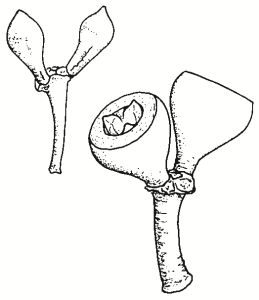Family:
Myrtaceae
Eucalyptus pauciflora
White Sallee
Other Names: Snow Gum, Cabbage Gum, Weeping Gum
First Nations Name(s):

Name Origin:
pauciflora — from Latin paucus, few, and florus, flowered, meaning few-flowered, although this is inappropriate as it often flowers profusely.
Regional Subspecies:
Occurrence:
Regional:
East of the Hume Highway at higher elevations.
Australia:
NSW, Vic, Tas, SA.
Habitat:
Grassy or dry sclerophyll woodland in flat cold sites above about 700 m elevation, on deeper soils.
Habit:
Tree to 20 m high (and sometimes 30 m), with white, grey or yellow smooth bark with scribbles.
Site Preference:
Mountain slopes, exposed ridgetops and tablelands in shallow rocky or alluvial well-drained soil. Tolerates frost, strong wind and long periods of heavy snow.
Characteristics:
Fast-growing when young.
Flowering:
White-cream, Oct-Jan. Prolific.
Seed Collection:
Summer, although seeds generally retained for long periods.
Propagation:
From stratified seed (± 500 viable seeds per gram). Combine seed with moist sand and refrigerate for 4-6 weeks at 15°C. Optimum germination temperature 15°C. Seedlings may not survive in sterile potting mix. Adding local soil should overcome problems.
Regeneration:
From seed and lignotubers.
VALUES:
Shade & Shelter:
Useful medium-level cover in windbreaks.
Land Protection:
Valuable in highland areas for controlling erosion and intercepting snow drift.
Wildlife:
Valuable habitat. Hollows used for nesting. Nectar source for native birds and insects. Insect- eating birds attracted.
Fuel:
Moderate value. Used where it occurs.
Timber:
Light pink-brown, relatively soft, light and moderately strong, with gum veins. Density about 690 kg/m3.
Ornamental:
Attractive due to pendulous foliage and colourful pink bark during summer.
Other:
Leaves produce yellow dye with mordant alum.
